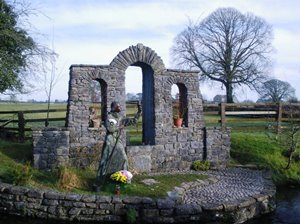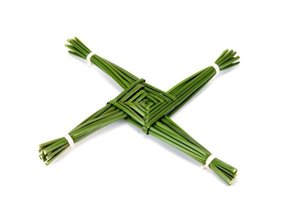Many people across the globe know all too well about
St, Patrick’s Day in Ireland, an event that is also celebrated in many other parts of the world. But did you know there is another notable day in Ireland, honouring another very famous saint? The day is question is February 1
st and the holy figure being celebrated is Saint Brigid.
Christianity belief
.jpg?width=300&height=168)
It is said that Brigid was born in what is now known as the townland of Faughart in Co. Louth, a stones throw from the border in County Armagh. She was born into nobility, with her father, Dubtach, being a prominent chieftain, but unusually for the time, her mother was once a slave.
His young daughter caused him much annoyance with her penchant for giving away the valuable goods he would bestow upon her, to poor people who resided in his fiefdom. Dubtach was still a pagan, while his wife and daughter were part of the new Christian believers in Ireland and this would have added to the discord between them.
Because of this, Dubtach wanted Brigid out of his sight so he offered her hand to the King of Leinster. However, upon the realisation of the hassle Brigid caused her father and his courtiers, he granted the future saint her freedom and she was now free to go and do what she liked.
While most women of her status and age were seeking a husband, Brigid instead travelled to Croghan Hill in what is now county Offaly to train in ministry under saint Maccaile, who had a church settlement there. Initially, Maccaile gave her short shrift, as he could not comprehend that a daughter from such a powerful family would want to live the humble life of a priest, but her words and deeds eventually won him over.
A few years later, after what we would now say was having served her apprenticeship in Cloghan; it is said she travelled 27 kilometres west, where her first monastic settlement was established in what is now known as the town of Clara in county Offaly. From Clara, Brigid continued to tour the country converting more people to Christianity wherever she went.
Around 480 A.D., the venerable saints’ biggest and most remarkable settlements began life in what is now Kildare town. With the help of St, Conleth, this sprawling settlement played a key role in cementing the status and foothold of Christianity in the province of Leinster. However, very little now remains of the original monastic settlement. The arrival of the Norman’s and their stone structures brought about a much bigger and ostentatious structure, which one would witness today, as they walked through Kildare town. Learn more about St. Conleth and St. Brigid's time in Kildare
here.
The significance behind St. Brigid's Day

St. Brigid died in the year 525 and it is said the 1
st of February was the date. There are some who have questioned this date and claim it was not the real date of her passing and that church authorities claimed it was that date in an attempt to cut across an important festival in Paganism.
The festival on February 1
st is an event that marks the mid-point between the Winter Solstice and Spring Equinox and is celebrated by Wiccans and other practitioners of Paganism. The ewe is a potent symbol of this event as the act of it being born and drinking it’s mother’s milk is seen as a metaphor of the reawakening of the Northern Hemisphere.
St. Brigid's Cross

Many of you reading this will be able to recall having made a St. Brigid’s cross on February 1
st in school and you might also be wondering about the symbolism of this cross?
It is said that when her pagan father was dying, Brigid visited him and talked to him about her faith, and while doing so formulated a cross with some rushes she had picked up. Handing it to him, he asked to be baptised and thus died a Christian. Nowadays, making a St. Brigid’s cross and placing it in ones’ home is said to improve the health of those who live there.
There are numerous churches and school across Ireland and abroad named after Brigid and also numerous wells linked to her, which people will travel to on February 1
st to pray at. I wonder how many of you have travelled up Fonthill Road South to go to Liffey Valley Shopping Centre, not knowing that there was a Saint Brigid’s well on your left at Brideswell Lane, just past the Junction with Newlands Garden Centre?
Be it a Gaelic chieftain in early Christian times or John Henry Newman in 1845, the conversion of high profile figures to the Catholic faith, are events that are widely celebrated by members of that faith.
So now, when your child or grandchild brings you a St. Brigid’s cross they made, you might take a moment to remember this amazing woman from Faughart in Co. Louth.
Interested in learning more about the patron saints of Ireland? Check out our blog on St. Patrick
here.
Posted: 01/02/2022 14:18:34